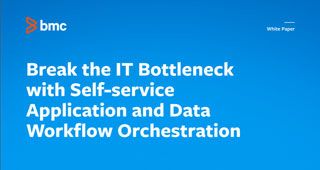What do ordering pizza and application and data workflow orchestration have in common? More than you might think. A few days ago, I was finishing up a project around the house and asked my daughter to order dinner from our favorite local pizza shop. She hopped on her mobile phone and placed the order through the DoorDash app. In less than an hour, two hot pizzas were on our doorstep. And because I’m a cool dad, I sent her money to pay for the dinner through my bank’s mobile app.
Today, we have more tech in our mobile phones than entire generations had before us—each with easy-to-use interfaces that give us self-service access to all the information and tools we need, prevent us from doing things we shouldn’t be able to, and are safe and secure to use. See where I’m going with this?
The same should be true for the business applications you use at work. If they are designed well, they will give you self-service access to the information or business services you need, whenever (and from wherever) you need it. They will be robust enough to help IT operations (IT Ops) teams manage security and compliance requirements, yet flexible enough to give teams throughout the organization targeted access to relevant data and functionality.
Your application and data workflow orchestration platform should meet those standards, too. If it doesn’t, it’s time to reevaluate. Here are four important self-service features to look for:
- Built for speed: Your platform should be easy to access and use, and it should provide a self-service portal with quick-start tutorials, how-to videos, and other tools, so users can easily find what they need. Mobile support and web interfaces are also must-have features.
- Targeted information and capabilities: The platform’s self-service interface should provide targeted information and functionality specific to each user’s role and needs. For example:
- Business users should only see the data and reports relevant to them. They shouldn’t have access to (or have to sort through) information or workflows for other teams.
- Developers and DevOps users should be able to make changes to application workflows, check the status of their applications, and inspect logs and outputs, all via code, to find root causes of problems or anomalous conditions.
- IT Ops must retain control over workflow orchestration throughout the entire organization. This includes having the ability to approve proposed changes from employees (or the option to give them complete autonomy, if desired).
- Role-based access: The platform must be designed so users can be given custom privileges for job creation, monitoring, and configuration. As business complexity grows, users may want to be more autonomous and set up workflow orchestration environments independently. Your platform should support this.
- Automated policy enforcement: IT Ops should be able to build enterprise policies and regulatory requirements into the platform, so they are automatically applied and enforced for all activities performed by self-service users.
Application and data workflow orchestration is no longer just an IT Ops discipline. It’s common for companies to have hundreds (or even thousands) of developers, business users, and others accessing and working in the workflow orchestration platform. This is good for the business. Giving employees autonomy through self-service functionality speeds innovation, fosters a culture of agility, and improves productivity. But it’s critical that companies take the right approach. Bottom line—flexibility, accessibility, ease of use, and security are paramount.
These are just a few of the many important self-service features your application and data workflow orchestration platform should provide. To learn more about the self-service features BMC has built in to Control-M check out this whitepaper.







